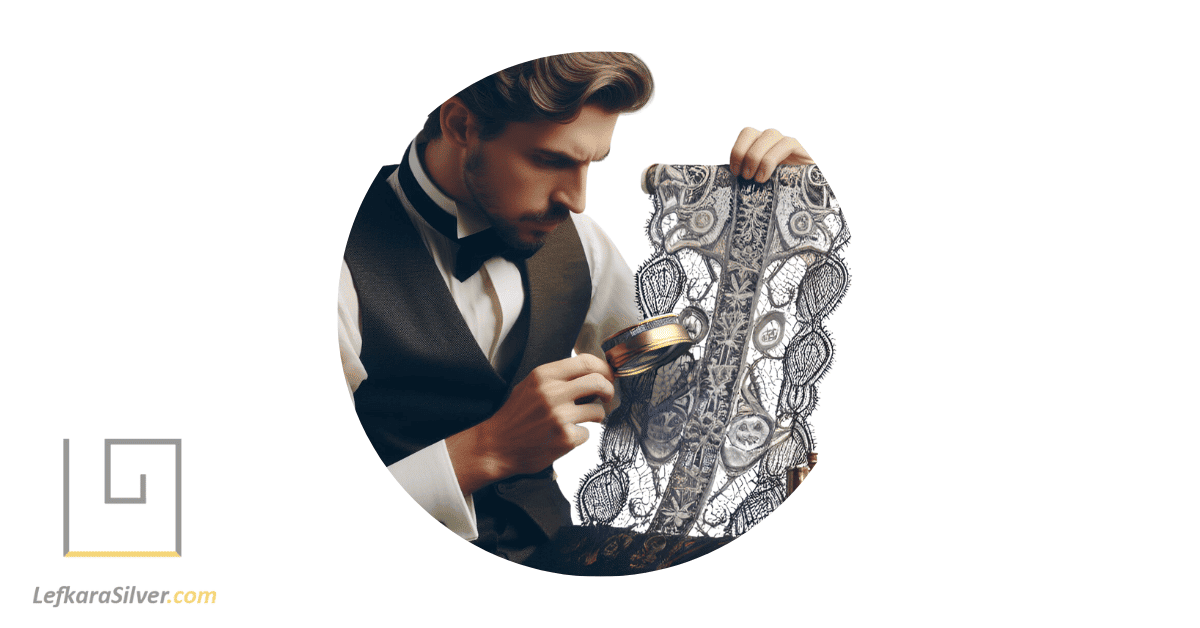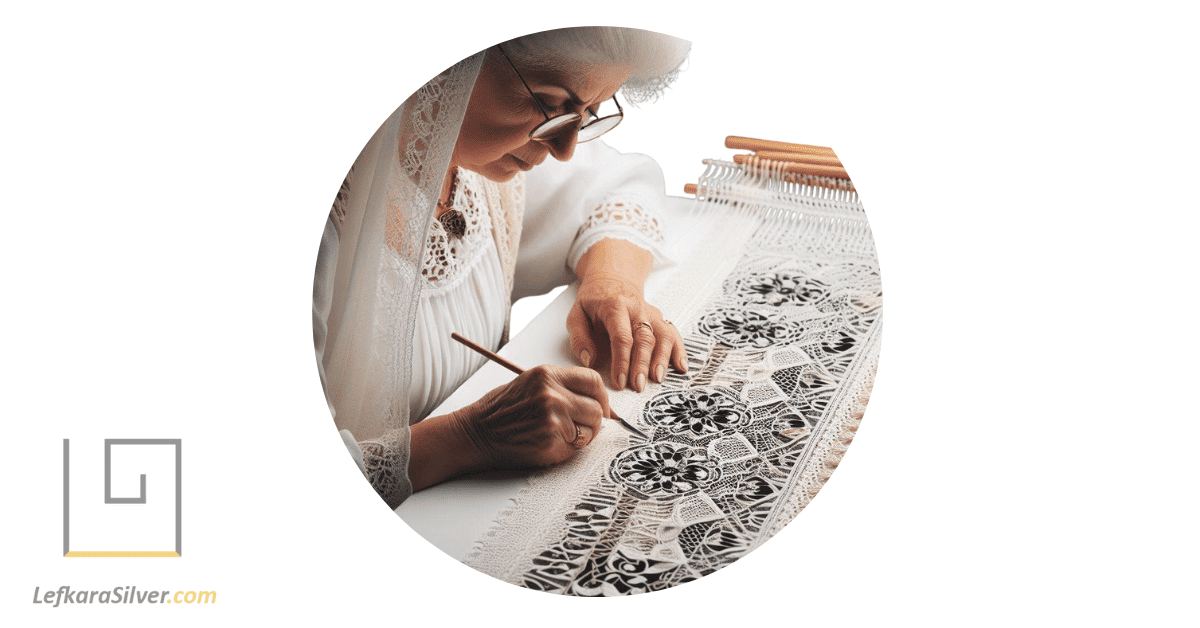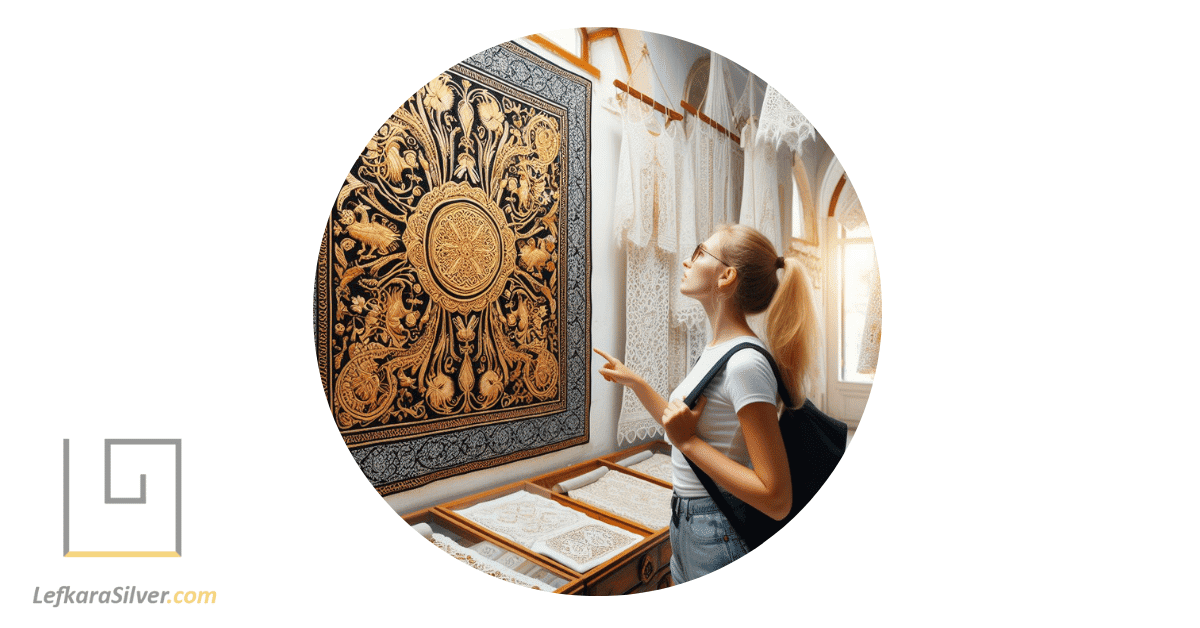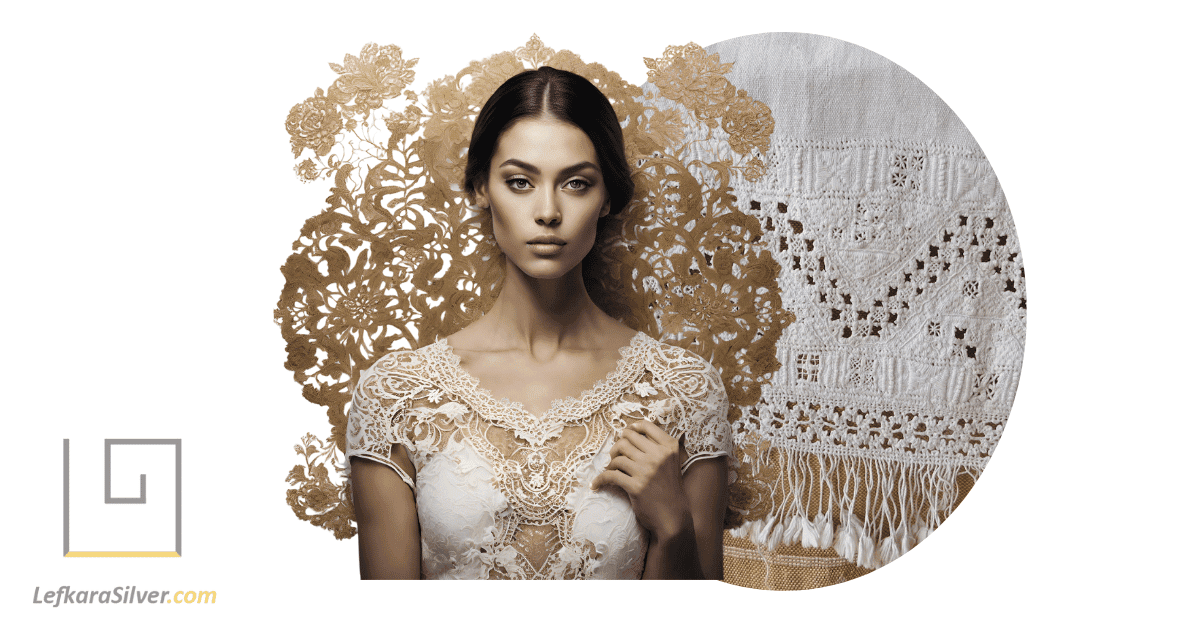Dive into the Realm of Cyprus Lace
Welcome to the enchanting world of Cyprus lace, a realm rich in history and brimming with intricate designs and skilled craftsmanship.
In this guide, we’ll explore various facets of this fascinating subject, including the 7 Best Cyprus Lace Shops, the history of Cyprus lace, the renowned lace villages of Cyprus such as Lefkara, Omodos, and Fyti, and the unique lace techniques and patterns that set Cyprus lace apart.
We’ll also delve into the art of Cyprus embroidery, the impact of lace on Cyprus tourism, and its influence on Cyprus fashion as of October 2024.
The History of Cyprus Lace: Unraveling the Threads
The history of Cyprus lace is a tapestry woven with threads of tradition, culture, and artistry. Let’s unravel these threads and delve into the rich history of this intricate craft.
The Birth of Lefkara Lace
Lefkara lace, or Lefkaritika, is a handmade lace from Pano Lefkara, Cyprus. This traditional craft of lace-making was inscribed on the Representative List of the Intangible Cultural Heritage in 2009. Notable characteristics of Lefkara lace include the hemstitch, satin stitch fillings, needlepoint edgings, and intricate geometric patterns. The Lefkarian technique is thought to have been born in the 15th century, during the Venetian rule.
The Influence of Venetian Courtiers
The embroidery of Venetian courtiers, who ruled Cyprus beginning in 1489, significantly influenced the development of Lefkara lace. Cypriot embroiderers added a local flavor to the adopted style of the Italian settlers.
The Evolution of Lefkara Lace
Lefkara lace is the evolution of an older type, called “asproploumia”. The main stitches of “asproploumia” survived in the newest type of Lefkaritika. New stitches and motifs were added depending on the skill and creativity of the embroideress.
The Role of Lace in Cypriot Society
Lace-making was at the center of daily life for the women of Lefkara and a proud symbol of their identity. Each girl had to have an extended collection ready for exhibition on her wedding day. Many women practiced embroidery as a profession as well.
The Spread of Lefkara Lace
Men from Lefkara, called “kentitarides”, were merchants who traveled across Europe and Scandinavia. According to tradition, in the 15th century, Leonardo da Vinci visited Cyprus and took a Lefkara Lace back to Italy, which today decorates the Duomo Cathedral in Milan.
Lefkara Lace Today
Today, these embroideries are manufactured throughout Cyprus, especially in villages like Kato Drys, Vavla, Vavatsinia, Ora, Choirokoitia, Skarinou, Dali, and Athienou. The lace-making tradition in the village of Lefkara in southeastern Cyprus dates back to at least the fourteenth century.
At Lefkara Silver, our filigree jewellery is meticulously crafted, drawing inspiration from the intricate patterns and designs inherent in the historic Lefkaritika tradition.

Top Picks: The 7 Must-Visit Cyprus Lace Shops
Regarding lace shopping in Cyprus, there’s no better place to start than the village of Pano Lefkara. Known for its traditional Cypriot embroidered lace, the well-known lefkaritiko, Pano Lefkara, is a treasure trove of exquisite lace shops. Each shop offers a unique selection of handcrafted pieces, from intricate tablecloths and napkins to stunning showpieces.
- Lefkara Arts & Crafts: Located in Pano Lefkara, Larnaca, Cyprus, this shop is known for its handmade silver and lace.
- Rouvis Lace and Silver: This shop, located in Pano Lefkara, Larnaca, Cyprus, offers silver and gold jewellery along with handmade “LEFKARITIKA” embroidery. It has received positive reviews for its fantastic family business.
- Da Vinci Handmade Lace-Center: Located in Nicosia, Cyprus, this shop gathers all the culture of Cyprus in its products. It is known for its clothing stores, jewelers, and watches.
- Helen’s Lace Shop: Located in Nicosia, this shop is known for its wide variety of Lefkara lace.
- Karagiorgi Maroulla: Another gem in Nicosia, Karagiorgi Maroulla offers a unique selection of handcrafted lace
- A & E Stores: Situated on Agiou Andreou Street in Limassol, A & E Stores is a go-to destination for lace enthusiasts3.
- L.Papaloizou-Cardiff Lefkara Lace Workshop & Silver: This shop is in Pano Lefkara, Cyprus. It is a fantastic family business and an absolute must-visit if you are in the beautiful village of Lefkara.
Be sure to check out our Filigree Jewelry collection to see how the beautiful legend of Lefkara lace inspires our designs.
Exploring the Lace-making Villages in Cyprus
Cyprus, an island nation in the Mediterranean, is renowned for its rich lace-making tradition. Here are some of the villages where this intricate craft continues to thrive:
- Pano Lefkara: This village is famous for its lace, known as lefkaritika. The cobbled limestone streets and picturesque architecture provide a charming backdrop for the women who sit working on their delicate embroidery.
- Kato Lefkara: Along with Pano Lefkara, it was one of the most significant centers of lace production.
- Omodos: Omodos is one of the most important centers for producing narrow-knit lacing.
- Fyti: Fyti is known for its fythkiotika, weaving on a loom.
- Kato Drys: Now one of the places where these embroideries are manufactured.
- Vavla: Another village where the tradition of lace-making is kept alive.
- Vavatsinia: In Vavatsinia, you can find artisans continuing the age-old tradition of lace-making.
- Ora: The village of Ora is also known for its lace production.
- Choirokoitia: Choirokoitia is another village where the lace-making tradition continues.
- Skarinou: In Skarinou, the lace-making tradition is still very much alive.
- Dali: Dali is another village where you can find beautiful examples of Cyprus lace.
- Athienou: In Athienou, lace-making tradition continues to be a significant part of the local culture.
These villages are the heart of Cyprus’ lace-making tradition, each contributing to the preservation and continuation of this beautiful craft. But now, let’s spotlight Lefkara, Omodos, and Fyti Lacing.

Lefkara Lace: The Pride of Cyprus
Lefkara lace, or lefkaritika, is a form of pulled thread embroidery with satin stitch details. This lace is a valued specimen of embroidered artwork, reflecting the strength and sensitivity of the region’s women. The lace-making tradition in Lefkara dates back to at least the fourteenth century, influenced by indigenous craft, the embroidery of Venetian courtiers who ruled the country beginning in 1489, and ancient Greek and Byzantine geometric patterns.
In 2009, Lefkara lace was added to the UNESCO list of intangible heritage items. Testament to the ability to appreciate multiple influences and incorporate them into one’s own culture, lace-making is at the center of daily life for women of Lefkara and a proud symbol of their identity.
The art of making Lefkara lace is passed down through generations, from mother to daughter, preserving the intricate techniques and patterns that define this unique craft. Each piece of lace tells a story woven with tradition and cultural identity threads. The women of Lefkara, with their nimble fingers and keen eyes, breathe life into these stories, transforming simple threads into works of art.
The process of making Lefkara lace is painstaking and time-consuming. It begins with carefully selecting the finest threads, followed by the meticulous process of pulling and counting threads to create distinctive geometric patterns. The satin stitch details are added, bringing depth and texture to the design. Despite the complexity of the process, the lace-makers of Lefkara approach their work with patience and dedication, understanding that their craft is not just about creating beautiful lace but also about preserving a piece of their heritage.
The recognition of Lefkara lace as a UNESCO intangible heritage item underscores its cultural significance. It is a testament to the skill and creativity of the lace-makers and a tribute to their resilience and commitment to keeping this age-old tradition alive. As we admire the beauty of Lefkara Lace, we are reminded of the rich cultural tapestry it represents, woven with threads of history, tradition, and the indomitable spirit of the women of Lefkara.
Omodos Lace: A Tapestry of Tradition
Omodos’ narrow-knit lacing, a gem of Cypriot heritage, is a testament to the island’s rich cultural tapestry. This intricate lacework, born in the charming village of Omodos, is a marvel of craftsmanship. Each stitch is a narrative woven with precision and patience, echoing centuries of tradition. The narrow-knit technique, a distinctive feature, adds a unique texture and complexity to the designs.
Narrow-knit lacing, as the name suggests, is characterized by its narrow, intricate patterns. This type of lace is often associated with high detail and precision, making it more complex and time-consuming than other types.
The materials used can also vary. While traditional lace was often made from silks, linen, and precious metals, modern lace can be made from various fibers, including silk, cotton, linen, rayon, and synthetic fibers. The main difference between narrow-knit lacing and other types of lace is the technique used to create them and the resulting patterns and textures.
The lace patterns, often inspired by nature and geometry, are a visual feast. The motifs are diverse and symbolic, from the humblest wildflower to the grandest Byzantine mosaic. The process, painstaking and time-consuming, involves deft hands and sharp eyes. It’s not just about crafting a piece of fabric; it’s about keeping a legacy alive.
Fyti Lace: Weaving a Legacy
Fyti lace, known as fythkiotika, is a vibrant tapestry of Cypriot culture steeped in history and tradition. Originating from the village of Fyti, the primary center of weaving craft in the Pafos rural area, fythkiotika is a testament to the island’s rich medieval heritage.
Its colorful and geometric patterns characterize Fythkiotika, each telling a story of everyday life. The designs, known as “Xoplia,” are separated by rows called “Mostres,” each with a unique name. The edges of Fyti weaves are finished off with white or colored “Klosia” (fringes with flocs), which are tied by hand.
The creation process of fythkiotika is a labor of love involving several stages, from gathering cotton to weaving it on a loom. Traditionally, weavers cultivated the cotton, prepared it for weaving, and turned it into yarn before placing it on the loom. Today, readymade thread is mainly used.
Fythkiotika, listed in the UNESCO Intangible Cultural Heritage Catalogue, is more than just a fabric. It’s a vibrant thread in the rich tapestry of Cypriot culture, a colorful testament to the island’s enduring legacy of craftsmanship.

Cyprus Lace Techniques: The Artistry Behind the Craft
The artistry behind Cyprus lace involves a combination of intricate techniques and a deep understanding of geometric patterns.
- Material Selection: The process begins with the careful selection of materials. Traditionally, Cyprus lace was made on linen and worked in white, cream, or ecru silk threads. More recent examples use DMC stranded or perlé cotton threads.
- Crafting by Hand: The lace is then crafted by hand, with the lace maker using a combination of hemstitch, cut work, satin stitch fillings, and needlepoint edgings to create intricate designs.
- Design Inspiration: These designs often feature geometric trellises enclosing stylized plant designs and patterns.
The lace-makers skill is passed down through generations, with young girls learning the craft through years of informal exposure and then formal instruction by their mother or grandmother. Once she has mastered her art, the lacemaker uses her imagination to design work that embodies tradition and her personality.
| Lace Type | Origin | Characteristics | Preservation |
|---|---|---|---|
| Lefkara Lace | Pano Lefkara, Cyprus | Fythkiotika fabrics are weaved on a loom and characterized by various colours. | Inscribed on the Representative List of the Intangible Cultural Heritage. |
| Omodos Lace | Omodos village, Troodos, Cyprus | Known for its lace embroidery. The tradition is sustained, studied, and promoted at the Omodos Centre for the Preservation of Lace. | The tradition is carried out by weavers trained by the Cyprus Handicraft Service. |
| Fyti Lace | Fyti, Paphos district, Cyprus | Fythkiotika fabrics are weaved on a loom and characterized by various colors. | The tradition is carried out by weavers trained by the Cyprus Handicraft Service. |
The Unique Patterns/Designs of Cyprus Lace
The patterns of Lefkara lace are influenced by indigenous craft, the embroidery of Venetian courtiers who ruled the country beginning in 1489, and ancient Greek and Byzantine geometric patterns. The lace is characterized by its white, brown, and ecru colors, and its geometric patterns.
Lefkara embroidery showcases a broad spectrum of stitches and patterns. Some are reminiscent of the Venetian era, others predate the Venetians, and a few are believed to be inspired by the cave art of Ayios Neophytos, a Cypriot hermit from the 12th century.
The creation of Lefkara lace involves a meticulous process of thread counting, resulting in predominantly geometric shapes. The embroidery comprises two main elements: (1) designs embroidered onto the fabric using the satin stitch and (2) designs that are cut and drawn after specific threads of the fabric have been removed.
The designs often bear names that reflect everyday objects. For instance, satin stitch designs include lanterns, crosses, forks, snails, and daisies, while cut and drawn designs are named after they resemble baskets, eyes, and fleas.
A distinctive feature of Lefkara lace is “the river,” a zigzag pattern created by cutting and drawing. It runs parallel to the fabric’s outer edges, with its arches enclosing triangular spaces filled with various designs.
Lefkara lace is also characterized by the designs along the fabric’s edges, known as tsimbi, closi, and tsimbocloso. A now obsolete design is a coarse lace crafted using the bobbin-lace technique prevalent in Europe.
In addition, Cyprus is known for its edging pattern. This pattern is printed in Weldon’s Practical Knitter, Series 14, Number 55, 1890, and can also be found in the facsimile series, Weldon’s Practical Needlework, Volume 5, Interweave Press, 2001.
The Stitched Stories of Cyprus Embroidery
Embroidery in Cyprus is a significant part of the local art scene. The materials used in Cypriot embroidery include cotton, flax, and silk. The main areas where embroidery flourished were Lefkara, Omodos, and Athienou.
There are two main categories of Cypriot embroidery: the multicolored embroidery (colored cross stitches etc) and the white embroidery (Lefkaritika embroidery, Larnaca laces “venis”, pipilles with a knot, crochet).
One of the most common types of embroidery in many villages in Cyprus is the needle lace “fervoulite” from Karavas, as well as “pipilles” and “krosiedes”. The “fithkiotika” and “lefkonitziatika” multi-colored laces, created when the cloth is woven on the loom, are also well known.

Cyprus Lace Tourism Tips: A Unique Cyprus Experience
For those interested in experiencing the rich tradition of lace-making and embroidery in Cyprus, there are several key locations to visit. Here are some tips to enhance your exploration:
Visit Lefkara Village: The village of Lefkara is a must-visit destination. Located in the Larnaca region, Lefkara is split into Pano Lefkara and Kato Lefkara (higher and lower Lefkara) and is world-renowned for its traditional handicrafts of lace embroidery and filigree silver. Considered the heart of lacemaking, Lefkara boasts a charming atmosphere and numerous shops showcasing exquisite lace pieces. Witness artisans crafting lace and learn about the traditional techniques passed down through generations.
Explore Lace Museums: Immerse yourself in the history of lacemaking at museums like the Lefkara Lace Museum. These museums often house antique lace pieces and exhibits showcasing the cultural significance of lace in Cyprus.
Attend a Lacemaking Workshop: Get hands-on experience by participating in a lacemaking workshop. Learn the basic stitches and create your small lace piece, a unique souvenir to cherish.
Look beyond the tourist shops: Venture beyond the main tourist areas to discover hidden gems. Local artisans often sell their creations at family-run shops or stalls at traditional festivals, offering a more authentic experience and potentially better deals.
Appreciate the artistry: Remember, these are delicate works of art, not mass-produced items. Respect the time and skill invested in each piece by handling them carefully and considering their value when making purchases.
By following these tips, you can delve deeper into the captivating world of Cyprus lace, appreciating its beauty, craftsmanship, and cultural significance.
From Tradition to Trend: Cyprus Lace in Fashion
For centuries, Cyprus lace, with its intricate patterns and delicate craftsmanship, has been a treasured element of Cypriot culture. Today, this time-honored tradition is woven into the fabric of modern fashion, adding a touch of heritage and elegance to contemporary designs.
Designers are incorporating Cyprus lace in various ways. Some use it as statement pieces, creating dresses and tops with full lace bodices or skirts, evoking a sense of romance and femininity. Others opt for subtler touches, like lace trims on sleeves, collars, or pockets, adding a touch of texture and visual interest to garments.
The beauty of Cyprus lace lies in its versatility. Traditional geometric and floral motifs are reinterpreted for modern tastes while using different threads, like silk or cotton, to create a range of textures and looks. This allows designers to cater to diverse styles, from bohemian chic to classic elegance.
Incorporating Cyprus lace into modern fashion is not just about aesthetics but also about cultural preservation. You can find some signature pieces to inspire you on Etsy. By incorporating this traditional craft into their designs, artists create beautiful pieces and help keep this cultural heritage alive and relevant in the fast-paced fashion world.
A Round Up Of The Timeless Appeal of Cyprus Lace
The appeal of Cyprus lace in October 2024 extends beyond its beauty and craftsmanship. It’s a symbol of cultural heritage, a source of national pride, and a testament to the skill and creativity of Cypriot artisans.
To stay informed about new jewelry offers, news, and buying guides, follow our website, LefkaraSilver.com. Embrace the beauty and tradition of Cyprus lace and let it inspire your style!

Cyprus Lace FAQs
What Is Cyprus Lace?
Cyprus Lace, also known as Lefkara Lace or Lefkaritika, is a handmade lace from Pano Lefkara, Cyprus. It’s characterized by its hemstitch, satin stitch fillings, needlepoint edgings, and intricate geometric patterns. Ancient Greek and Byzantine geometric patterns influence the lace designs.
How Is Cyprus Lace Made?
Lefkara Lace is made by hand, combining four basic elements: the hemstitch, cut work, satin stitch fillings, and needlepoint edgings. The lace is usually sewn in only one color, although there are exceptions where two colors are used. The process is highly intricate and requires proper diligence.
What Is The History Of Cyprus Lace?
The lace-making tradition in Cyprus dates back to at least the 14th century. Lefkara Lace is thought to have been born in the 15th century, during Venetian rule, when Cypriot embroiderers added a local flavor to the adopted style of the Italian settlers. According to tradition, Leonardo da Vinci visited Cyprus in the 15th century and took a Lefkara Lace back to Italy, which today decorates the Duomo Cathedral in Milan.
What Makes Cyprus Lace Unique?
The uniqueness of Cyprus Lace lies in its intricate, exquisitely crafted handmade lace. It employs ancient Greek and Byzantine geometric patterns. The slots on the lace are large, the bridges between them small, and all the knots and ends are hidden. Such work requires proper diligence – a 100 x 100 cm tablecloth can take a whole year of hard work.
How Can I Identify Genuine Cyprus Lace?
Genuine Cyprus Lace, or Lefkara Lace, is characterized by its large slots, small bridges, and hidden knots and ends. Due to the clear weave, it’s typically made from high-quality thick linen, often French or Irish. The lace is usually sewn in only one color, although there are exceptions where two colors are used.
Where Can I Buy Authentic Cyprus Lace?
Authentic Cyprus Lace can be purchased in the small mountain village of Lefkara, close to both Larnaca and Limassol. It’s also available online on platforms like Etsy, where you can find various handmade Lefkara Lace products.
What Are The Different Types Of Cyprus Lace?
The most notable type of Cyprus lace is Lefkara Lace or Lefkaritika, a handmade lace from Pano Lefkara, Cyprus. Hemstitch, satin stitch fillings, needlepoint edgings, and intricate geometric patterns characterize it. Due to the clear weave, the lace is usually made from high-quality thick linen, often French or Irish.
How Is Cyprus Lace Different From Other Types Of Lace?
Cyprus Lace, specifically Lefkara Lace, is unique in its design and creation process. It employs ancient Greek and Byzantine geometric patterns. The lace is made by hand, combining four basic elements: the hemstitch, cut work, satin stitch fillings, and needlepoint edgings. This makes it distinct from other types of lace, such as bobbin lace, crochet, needle lace, and tatting.
How Can I Care For And Maintain Cyprus Lace?
Caring for Cyprus Lace requires diligence due to its intricate design and delicate nature. The lace is usually sewn in only one color, although there are exceptions where two colors are used. To maintain its quality, it’s recommended to use high-quality thick linen, often French or Irish, due to the clear weave.
What Are The Traditional Patterns Found In Cyprus Lace?
Traditional patterns in Cyprus Lace, particularly in Lefkara Lace, are mainly geometric and intricate. The most characteristic pattern in Lefkara Lace is “potamoi” (rivers), made from triangular zig-zags called “kamares” (arcs). Other frequently used motifs include “Do not forget me”, “Palm Grove”, “Margarita”, “Mosaic”, and popular web designs.
What Are Some Popular Uses Of Cyprus Lace?
Cyprus Lace, especially Lefkara Lace, is often used to create heirloom lace tablecloths. These are still the principal occupations of many women in the village of Lefkara. Additionally, Cyprus Lace is a popular choice for creating distinctive napkins and showpieces.
How Has Cyprus Lace Influenced Fashion?
Cyprus Lace, particularly Lefkara Lace, has significantly influenced fashion. Its intricate design and exquisite craftsmanship have made it a sought-after material in the fashion industry. The lace has even caught the attention of renowned figures like Leonardo da Vinci, who traveled to the village of Lefkara to purchase pieces of lace created there for use in adorning Milan Cathedral. This highlights the significant influence of Cyprus Lace on global fashion trends.

